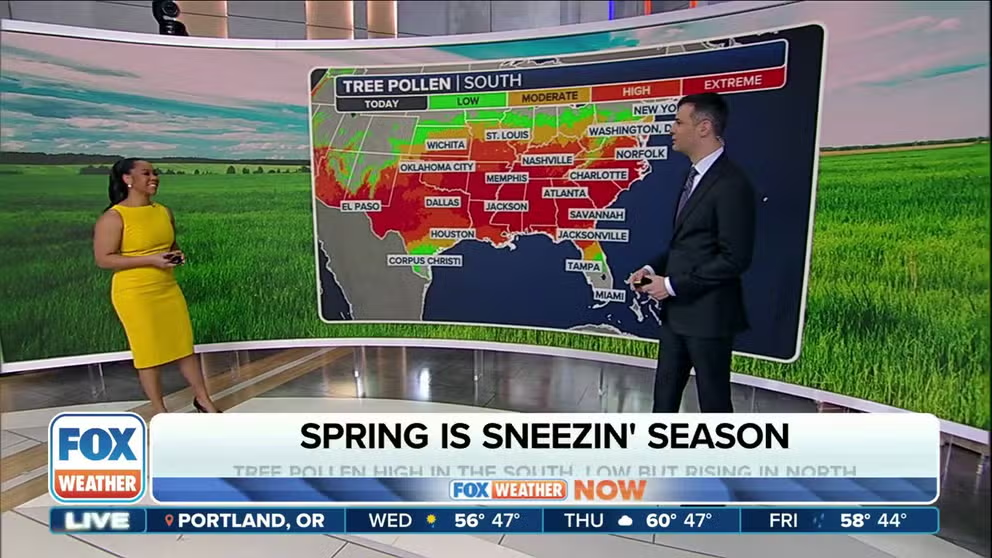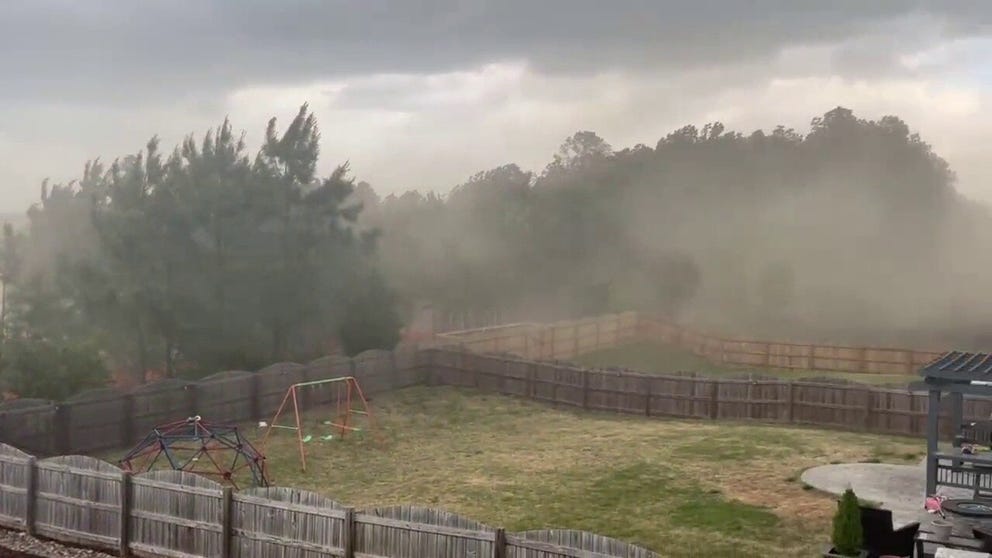What are the worst and best cities to live if you suffer from allergies?
The Asthma and Allergy Foundation of America released their Allergy Capitals 2024 report, rankings of the 100 biggest cities from best to worst for allergy sufferers.
Spring allergies are here, fight back
Spring allergies beat the first day of spring this year. Trees are blooming ahead of schedule across the southern half of the U.S.. Dr. Jeanette Nesheiwat joins FOX Weather with the best ways to fight back against the pollen assault.
If you are sneezing and sniffling from allergies, it may be where you live. The Asthma and Allergy Foundation of America just released their list of the best and worst places to live for allergy sufferers.
Researchers analyzed the 100 most populated cities in the continental U.S. for pollen levels (weed, tree and grass), the amount of over-the-counter medicine sold and access to allergy doctors to assemble the 2024 Allergy Capitals.
Midwest, Mid-Atlantic most challenging for allergy sufferers
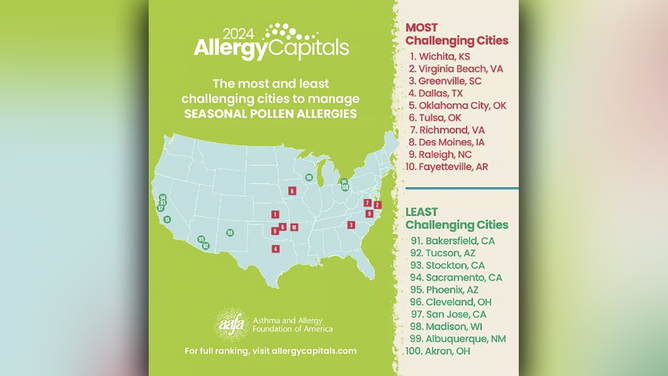
The best and worst places for allergy sufferers in the U.S.
(Asthma and Allergy Foundation of America / FOX Weather)
Wichita, Kansas takes the top spot for allergy suffering because of the high levels of tree and grass pollen, high medicine use and few allergy specialists, the report said.
Not unexpected, many of the "worst" cities are clustered in the warm South and more specifically the Southeast and Southern Plains. The "best" cities are clustered in the Desert Southwest with limited vegetation. The Great Lakes are also home to a cluster of "best cities." They have a shorter growing season and winds disperse the pollen and occasional rains knock pollen levels down.
Dallas takes the top spot for tree pollen - the most common cause of spring allergies, according to AAFA. Traditionally, trees produce pollen from February through June, but in warmer climes, they can procure pollen as early as December and January.
HERE ARE THE WORST SPRING ALLERGENS THAT WILL MAKE YOU COUGH, SNEEZE AND RUB YOUR WATERY EYES
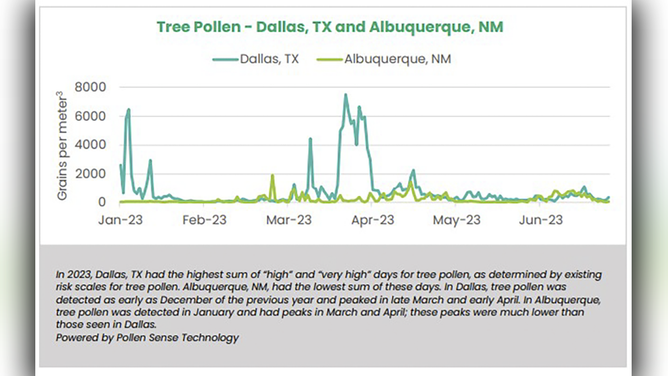
Dallas has the highest level of tree pollen while Albuquerque has the least tree pollen.
(Asthma and Allergy Foundation of America / FOX Weather)
San Diego has the highest number of "high" grass pollen days with 216. Grass grows year round in warmer cities. Grasses cause most late spring and summer allergies.
SPRING JUST STARTED BUT ALLERGIES ALREADY A HEADACHE FOR MILLIONS ACROSS US

San Diego had 216 days in 2023 in the "high" range for grass pollen.
(Asthma and Allergy Foundation of America / FOX Weather)
Milwaukee saw the highest number of "high" and "very high" days for weed pollen. Ragweed is the worst offender, said AAFA. About one out of seven people are allergic to ragweed pollen.
The weed peaks in mid-September and one plant can produce billions of pollen grains that can travel in the air for hundreds of miles. The season stretches for six to ten weeks.
PETS CAN SUFFER FROM ALLERGIES
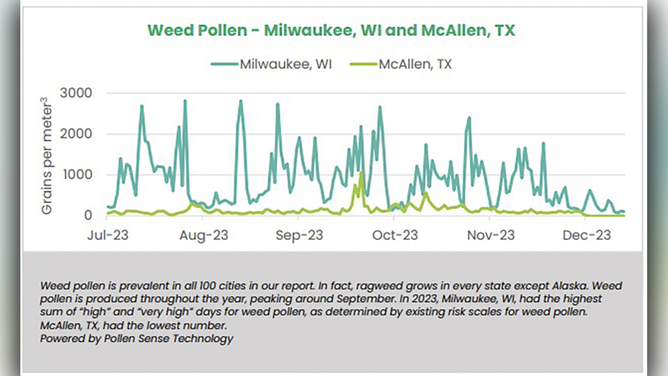
Milwaukee tops the list for weed pollen.
(Asthma and Allergy Foundation of America / FOX Weather)
One city that no longer made the list was Scranton, Pennsylvania, but don't celebrate just yet.
The city took the top spot in 2022 and ranked No. 3 in 2023. But this year, it just fell off the 100 most populated cities list, instead replaced by Fayetteville, Arkansas. In fact, the AAFA reports Scranton would have come in second had it qualified.
Allergies are more than an irritation
Seasonal allergies are more than just an irritation; they lead to illnesses like sinus infections, lost days of work and school and even hospitalization.
"With over 100 million people affected by allergies, it’s the sixth-leading cause of chronic illness in the U.S.," said Melanie Carver, AAFA Chief Mission Officer in a statement. "Allergies are a common asthma trigger and lead to increased hospital visits for asthma during peak pollen seasons."
About one in four adults and one in five kids suffer from seasonal allergic rhinitis, AAFA said. Allergy induced asthma, allergic asthma, is common in childhood and decreases through adulthood.
Watch: Gusty winds create pollen storm in North Carolina
Gusty winds create a pollen storm in Wake Forest, North Carolina on Tuesday afternoon.
Pollen season has been getting worse
The report states that the tree growing season starts 20 days earlier and lasts 10 days longer than it did 30 years ago, which means more pollen. The warm winter also has many plants blooming earlier than normal.
Each tree produces more pollen and more allergic pollen, stronger allergenicity, than in the past, the report continues. Since 1990, pollen seasons have netted 20% more pollen.
"Researchers say that climate change is responsible for about 50% of the increase in pollen seasons and about 8% of the increase in pollen concentrations," states the report.
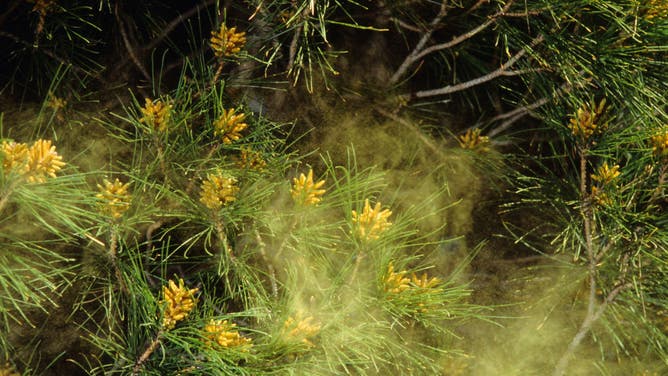
Airborne cloud of pine pollen from male pine cones, Pinus species, Bisbee, Arizona, USA, (Photo by Wild Horizons/Universal Images Group via Getty Images)
(Wild Horizons/Universal Images Group via Getty Images / Getty Images)
Some cities now have year-round pollen. Warmer temperatures have also led to an increased urban heat island effect in cities. The warmth stimulates pollen production, according to AAFA. Increasing air pollution can also trap more pollen.
"Climate change fuels a perfect storm of conditions that make allergy season worse for people with pollen allergy," said AAFA President and CEO Kenneth Mendez in a statement. "Longer growing seasons mean more exposure to pollen allergy triggers. Additionally, pollen counts tend to rise with warmer temperatures. Now, we see both more days of exposure to pollen and higher daily pollen counts leading to more intense, longer-lasting symptoms."
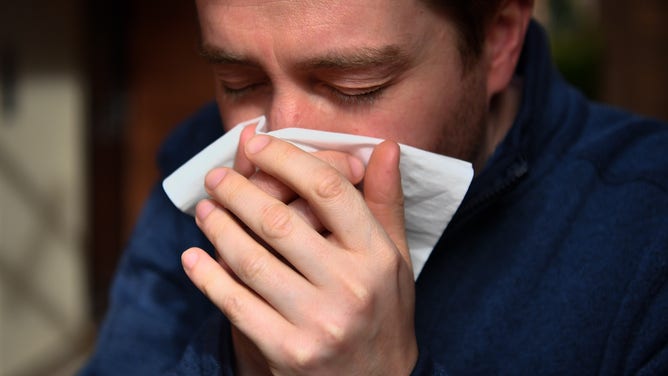
As we transition into fall and winter indoor allergies become more of an issue for many Americans.
(Ben Birchall/PA Wire / Getty Images)
ALLERGY SUFFERERS, YOU MIGHT BE CLEANING YOUR HOUSE ALL WRONG
Minimize the suffering
The AAFA has tips to lower your contact with pollen:
- Low pollen days: Plan outdoor activities.
- High pollen days: Stay inside. When you are outside, wear sunglasses, a hat or head covering, and a mask to limit the amount of pollen that gets into your eyes, nose, mouth, and lungs.
- Remove your shoes before entering your home.
- Change and wash clothes after outdoor activities.
- Wipe furry animals off when they come inside or bathe them weekly.
- Shower before bed to keep pollen out of your bedding.
- Keep windows closed during pollen season or peak pollen times (usually midday).
- Use central air conditioning or air cleaners with a HEPA or CERTIFIED asthma & allergy friendly® filter, if possible.
- Clean bedding, floors, and fabric furniture once a week.
- Clean blinds, curtains, and washable rugs once a month.
- Look into replacing wind-pollinating trees with fruiting trees that don't release pollen.
